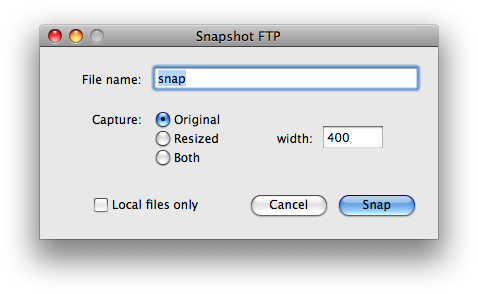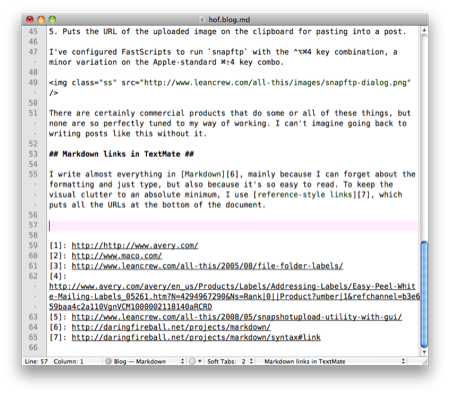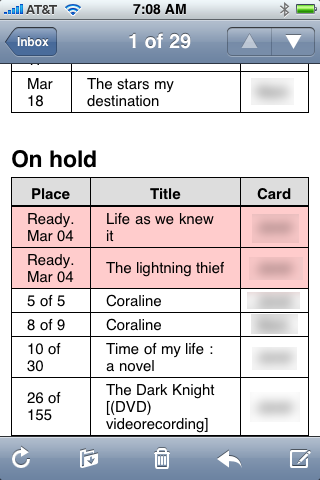My script hall of fame
January 27, 2010 at 1:25 PM by Dr. Drang
Many of my posts here have been about the writing—or rewriting or rerewriting—of scripts to automate the dull, repetitive, clicky-click tasks so common to computer use. While almost all of these scripts have been worthwhile, a few have proved so useful that I use them on a weekly or even daily basis. These are the member of my personal scripting hall of fame.
Folder labels
I like the project file folders in my office to have crisp laser-printed labels. There are plenty of templates out there for Avery labels and their clones, but they’re usually made for MS Word or some other program I don’t use. Also, there’s a lot of repetitive typing associated with those templates, and I obviously want to avoid that. So I wrote a script called pflabels that takes plain text input in a simple format and generates output for printing on a sheet of 1″×4″ labels (Avery 5261 or the equivalent).

The input looks like this:
#Kernighan Building|4215
Drawings
Contract
Correspondence
Photographs and
videotape
#Ossanna Residence|4332
Report
Correspondence
The headings, which have the project name and number separated by the pipe character (|), are denoted with an initial hash symbol (#), and individual labels are separated by blank lines. If I’m going to make several labels for the same project (which is usually the case), I need only enter the heading once. The script takes two options, -r and -c, which tell it which row and column to start on, so it can print on label sheets that have been partially used.
I generally type up my label input in TextMate and then run pflabels on that input via the Text>Filter Through Command… (⌥⌘R) command.
Screenshot uploader
This script, called snapftp:
- Takes a snapshot of some portion of my computer screen.
- Names it.
- (Optionally) resizes it.
- (Optionally) uploads it to my blog.
- Puts the URL of the uploaded image on the clipboard for pasting into a post.
I’ve configured FastScripts to run snapftp with the ⌃⌥⌘4 key combination, a minor variation on the Apple-standard ⌘⇧4 key combo.

There are certainly commercial products that do some or all of these things, but none are so perfectly tuned to my way of working. I can’t imagine going back to writing posts like this without it.
Markdown links in TextMate
I write almost everything in Markdown, mainly because I can forget about the formatting and just type, but also because it’s so easy to read. To keep the visual clutter to an absolute minimum, I use reference-style links, which puts all the URLs at the bottom of the document, out of the flow of the text.

I use three TextMate command/snippet/macros to do this:
- One for inserting links as I type, triggered by ⌃L.
- One for inserting links after I’ve already typed out the text, triggered by ⌃⌥L.
- One for inserting Google’s I Feel Lucky link on text already typed, triggered by ⌃⌥⇧L.
The first two are described here, and the third is described here. They’re a bit complicated to set up but are wonderfully simple to use. I should probably turn them into a Bundle for easier installation.
URL getters for TextExpander
This started out as a set of scripts for getting the URL (or a shortened version of the URL) of the page showing on the visible tab of the frontmost Safari window, and the scripts were triggered by key combinations defined in FastScripts. Then, after seeing this tip by Jeff Gamet, I turned them into a set of TypeIt4Me snippets. When I switched from TypeIt4Me to TextExpander, I moved the snippet over and that’s what I use today.
The two workhorses are:
- The snippet triggered by
;furl, which gets the aforementioned URL and inserts it. - The snippet triggered by
;surl, which gets the URL, shortens it through the Metamark shortening service (run by perl.org), and inserts it.
I tend to use the first when writing posts like this or email and the second when using links on Twitter. The great advantage is that I can add a link to a page I’ve been reading without having to switch back to Safari to get it.
More recently, I added a few more snippets for getting the URLs of the first, second, third, and fourth Safari tabs, regardless of whether they are frontmost.
BBC Radio recording scripts for Audio Hijack Pro
These scripts, written in Python and AppleScript, differ from those described above in that I never actually run these scripts myself. They’re run automatically on a schedule set in Audio Hijack Pro, and they record and tag certain BBC Radio 2 shows and put them into my iTunes library for syncing with my iPod. In effect, they turn shows that aren’t podcasts into podcasts for me.
The scripts are described here and they’re also available in this GitHub repository.
Library loan tracking
This script, like the set of BBC scripts, is run automatically—in this case, by a launchd process. Every morning, it logs in to my local library and gathers information on all the items my family has checked out or on hold. It then sends that information to my wife and me in a nicely formatted email.

Now it’s true that my library emails us a notice shortly before an item is due, but the advantage of this system is that we see everything at once and can gather up all the books that will be due in the next several days before going to the library to make a return. And we don’t have to remember to sign on to the library’s web site; the information is delivered to us every day.
Suspend and sleep screen
This is a pretty recent script, but I’ve come to love it. Without logging me out, it suspends my user session and puts the display to sleep. Seeing the Desktop swing around in that cube animation (which I’ve been a fan of since Andy Hertzfeld used a simplified version of it in Switcher) has become the visual signal that my day at work is over.
